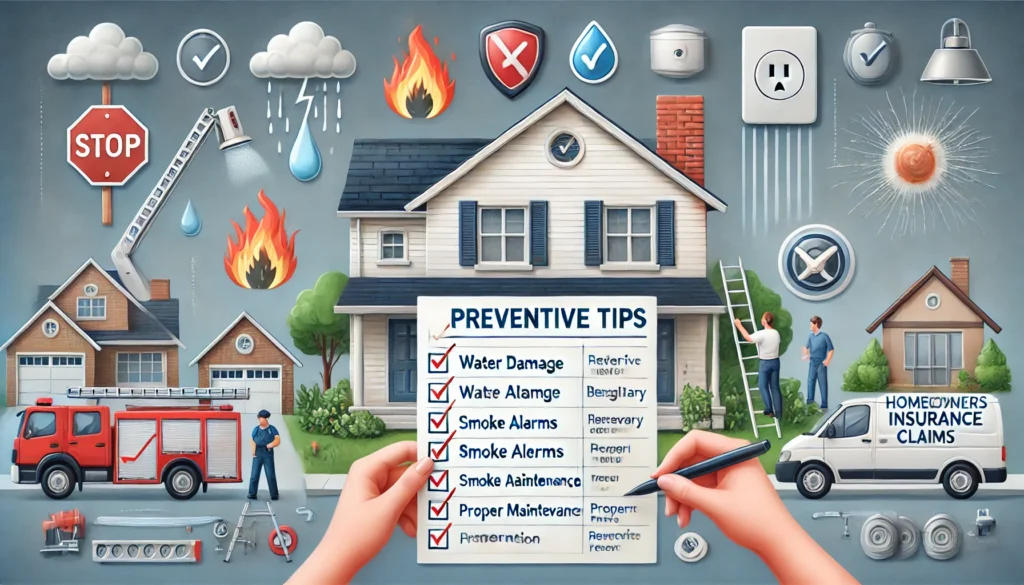Homeowners insurance is essential for protecting one of your most valuable assets: your home. However, with the rising costs of homeownership, many people are looking for ways to reduce their expenses, including insurance premiums. Fortunately, there are numerous strategies you can employ to lower your homeowners insurance premiums without sacrificing coverage.
This comprehensive guide will walk you through actionable tips and insights to help you reduce your premiums, save money, and still maintain the peace of mind that comes with adequate homeowners insurance coverage.
Table of Contents:
- Understanding How Homeowners Insurance Premiums Are Calculated
- Shop Around and Compare Insurance Providers
- Bundle Policies with the Same Provider
- Increase Your Deductible
- Strengthen Your Home’s Security
- Make Your Home Disaster-Resistant
- Maintain a Good Credit Score
- Avoid Making Small Claims
- Review and Update Your Coverage Regularly
- Inquire About Discounts You May Qualify For
- Pay Your Premium Annually Instead of Monthly
- Consider Renovations or Upgrades to Lower Premiums
- Take Advantage of Loyalty Discounts
- Remove or Reduce Coverage for High-Risk Items
- Work with an Insurance Agent or Broker to Find the Best Deals
- Conclusion
1. Understanding How Homeowners Insurance Premiums Are Calculated
Before you can effectively lower your homeowners insurance premiums, it’s essential to understand the factors that influence how your premium is calculated. Insurance companies assess various risk factors to determine the likelihood of you filing a claim. These factors include:
- Location of your home: Homes in areas prone to natural disasters or high crime rates generally have higher premiums.
- Age and condition of your home: Older homes may have outdated systems (electrical, plumbing, roofing) that increase the risk of damage or fire, leading to higher premiums.
- Claims history: If you’ve filed multiple claims in the past, insurers may consider you a higher risk, resulting in a higher premium.
- Credit score: In many regions, insurance companies use your credit score to assess how likely you are to file a claim.
- Coverage limits and deductible: The more coverage you have and the lower your deductible, the higher your premium will be.
By understanding these factors, you can take strategic actions to mitigate your risks and lower your insurance costs.
2. Shop Around and Compare Insurance Providers
One of the most straightforward ways to lower your homeowners insurance premiums is to shop around and compare quotes from multiple insurance providers. Premiums can vary significantly from one company to another, even for the same level of coverage.
Steps for Effective Comparison:
- Get at least three quotes: Reach out to at least three different insurance companies and compare their rates for the same level of coverage.
- Use online comparison tools: Many websites allow you to compare quotes from multiple providers in one place, saving you time and effort.
- Consider customer service and reviews: While cost is important, don’t overlook the quality of customer service and the provider’s reputation for handling claims efficiently.
- Bundle other policies for discounts: Many insurers offer discounts if you bundle homeowners insurance with other types of coverage, such as auto or life insurance.
By investing time in comparison shopping, you can potentially save hundreds of dollars annually on your insurance premiums.
3. Bundle Policies with the Same Provider
One of the easiest and most effective ways to lower your homeowners insurance premium is to bundle your policies with the same insurance provider. Many insurance companies offer discounts of up to 25% if you purchase multiple types of insurance from them, such as auto, life, or even umbrella policies.
How Bundling Works:
- Multiple policies, one provider: When you purchase homeowners and auto insurance (or other types of insurance) from the same company, they often offer a discount on both policies.
- Simplified billing: Bundling also makes managing your insurance policies more convenient, as you’ll receive a single bill for all your policies.
While bundling can offer significant savings, it’s still important to ensure that each individual policy offers the coverage you need. Be sure to review the details before signing up.
4. Increase Your Deductible
A deductible is the amount you pay out of pocket before your insurance coverage kicks in. Increasing your deductible is one of the simplest ways to lower your homeowners insurance premiums.
Key Considerations for Increasing Your Deductible:
- Balance savings and risk: While a higher deductible can significantly lower your premiums, make sure you can afford to pay the deductible out of pocket in the event of a claim.
- Common deductible amounts: The most common deductible amounts range from $500 to $1,500. Increasing your deductible from $500 to $1,000 could reduce your premium by 10% to 20%.
- Deductibles for specific risks: Some policies have separate deductibles for specific risks, like wind, hail, or earthquake damage. Make sure you understand your policy and the deductible amounts for each type of peril.
By opting for a higher deductible, you assume more of the financial responsibility for smaller claims, but you also benefit from reduced monthly premiums.
5. Strengthen Your Home’s Security
Improving your home’s security not only protects your family and belongings but can also result in lower insurance premiums. Insurance companies often offer discounts for homes that have enhanced security measures in place because these features reduce the risk of theft and property damage.
Security Features that Lower Premiums:
- Install a burglar alarm: Homes with professionally monitored security systems can often receive discounts of up to 20%.
- Add surveillance cameras: Visible security cameras deter potential burglars, and some insurance providers offer discounts for homes with this added layer of protection.
- Upgrade door and window locks: Reinforcing entry points with deadbolts and high-quality locks can reduce the risk of break-ins, potentially lowering your premium.
- Smart home technology: Some insurers offer discounts for homes equipped with smart technology like video doorbells, smart locks, and sensors that detect motion or broken windows.
If you’re considering upgrading your home security, ask your insurance provider about potential discounts before making any purchases.
6. Make Your Home Disaster-Resistant
Homes that are well-prepared to withstand natural disasters are less likely to suffer severe damage, which in turn lowers the risk for insurers. Many insurance companies offer discounts to homeowners who take steps to make their homes more resistant to natural disasters like hurricanes, earthquakes, or wildfires.
Disaster-Resistant Upgrades:
- Storm shutters: Installing storm shutters can protect windows from wind damage and flying debris during hurricanes.
- Reinforced roofing: Upgrading your roof to impact-resistant materials or reinforcing it with storm straps can make it more resistant to high winds.
- Fire-resistant materials: If you live in an area prone to wildfires, consider using fire-resistant materials for your roof, siding, and landscaping.
- Seismic upgrades: In earthquake-prone areas, retrofitting your home with seismic anchors or bracing your foundation can reduce the risk of structural damage.
These upgrades may require an upfront investment, but the long-term savings in premiums and potential repair costs can be significant.
7. Maintain a Good Credit Score
In many regions, insurers use your credit score as part of their risk assessment when determining your premium. Homeowners with better credit scores are seen as more financially responsible and are therefore less likely to file frequent claims. As a result, they are often rewarded with lower premiums.
How to Improve and Maintain Your Credit Score:
- Pay bills on time: Consistently paying your bills, including credit cards and loans, on time helps boost your credit score.
- Keep credit card balances low: Aim to use no more than 30% of your available credit limit.
- Avoid unnecessary credit inquiries: Each time you apply for credit, a hard inquiry is placed on your credit report, which can temporarily lower your score.
- Review your credit report for errors: Regularly check your credit report for inaccuracies or signs of fraud, and dispute any incorrect information with the credit bureaus.
Maintaining a high credit score can lead to lower insurance premiums, along with better rates on loans and credit cards.
8. Avoid Making Small Claims
Filing multiple claims can lead to higher premiums over time. Insurance companies often view frequent claim-filing as a sign of increased risk, even if the claims are for small amounts. In some cases, filing a claim can even lead to non-renewal of your policy.
When to Avoid Filing a Claim:
- Out-of-pocket costs: If the cost to repair damage is only slightly above your deductible, it might make sense to pay for the repairs out of pocket instead of filing a claim.
- Minor incidents: For minor damage, such as a broken window or small water leak, it’s often more cost-effective to handle the repairs yourself than to involve your insurance company.
- Frequency of claims: If you’ve already filed a claim within the past few years, consider whether filing another claim is worth the potential increase in your premium.
By reserving your insurance for major events or significant losses, you can avoid premium hikes and keep your policy in good standing.
9. Review and Update Your Coverage Regularly
As time passes, your home and circumstances may change, and your insurance needs could evolve. Reviewing your homeowners insurance policy annually ensures that you have the right amount of coverage—and that you’re not overpaying for coverage you no longer need.
Key Aspects to Review:
- Coverage limits: As your home’s value increases or decreases, you may need to adjust your dwelling coverage to reflect current replacement costs.
- Personal belongings: If you’ve sold valuable items or acquired new assets, you may need to adjust your personal property coverage.
- Home improvements: If you’ve made significant renovations or upgrades, such as adding a new roof or finishing a basement, make sure your policy reflects these changes.
- Policy exclusions: Review any policy exclusions and consider whether you need additional coverage for risks like flooding, earthquakes, or other natural disasters.
Updating your coverage ensures that you’re not paying for protection you don’t need, and that your policy reflects the current state of your home and belongings.
10. Inquire About Discounts You May Qualify For
Insurance companies offer a wide range of discounts that can help lower your homeowners insurance premiums. However, not all of these discounts are advertised, so it’s essential to ask your provider about any savings opportunities you may qualify for.
Common Discounts Include:
- New home discount: If your home is new or recently constructed, you may qualify for a discount.
- Claims-free discount: Some insurers offer discounts to homeowners who haven’t filed a claim within a certain period, usually three to five years.
- Loyalty discount: If you’ve been with the same insurance company for several years, you may be eligible for a loyalty discount.
- Senior citizen discount: Some insurance providers offer discounts to retirees or senior citizens, as they are often home more frequently and can prevent risks like fires or burglaries.
- Green home discount: Homes that are energy-efficient or use sustainable building materials may qualify for a green home discount.
Ask your insurer for a full list of available discounts to ensure you’re taking advantage of every possible opportunity to reduce your premium.
11. Pay Your Premium Annually Instead of Monthly
While it might be convenient to pay your homeowners insurance premium in monthly installments, many insurance companies charge a processing fee for this service. If you can afford to pay your premium in full annually, you can avoid these additional fees and may even receive a discount for paying upfront.
Benefits of Annual Payments:
- Avoid extra fees: Monthly billing often comes with administrative fees that can add up over time.
- Discounts for paying in full: Some insurers offer a small discount, typically 2% to 5%, for homeowners who pay their premiums in full at the beginning of the policy period.
Paying annually not only saves you money on fees but also simplifies your financial planning by reducing the number of bills you need to manage each month.
12. Consider Renovations or Upgrades to Lower Premiums
Certain home improvements or renovations can help lower your homeowners insurance premiums, especially if they reduce the risk of damage or accidents.
Renovations That Can Lower Your Premium:
- Roof replacement: Installing a new roof, particularly one with impact-resistant materials, can reduce your risk of storm damage and lower your premium.
- Electrical system upgrades: Replacing outdated wiring and electrical systems can reduce the risk of fire, which often results in a premium discount.
- Plumbing updates: Upgrading old plumbing systems can lower the likelihood of water damage, leading to potential savings on your insurance policy.
- Energy-efficient upgrades: Installing energy-efficient windows, doors, or insulation can not only lower your utility bills but also qualify you for green home discounts from your insurer.
Before starting any renovation project, consult your insurance provider to find out which improvements could lead to premium reductions.
13. Take Advantage of Loyalty Discounts
Many insurance companies offer loyalty discounts to customers who have been with them for several years. These discounts may increase over time, rewarding long-term customers for their commitment.
How to Maximize Loyalty Discounts:
- Inquire about your discount: Ask your insurance provider about loyalty discounts and how they apply to your policy.
- Compare loyalty discounts with other offers: While loyalty discounts are valuable, it’s still a good idea to shop around periodically to ensure you’re getting the best deal overall. Sometimes, switching to a new provider can offer better savings, even after factoring in loyalty discounts.
Loyalty discounts can add up over time, so it’s worth considering staying with the same insurer if they consistently offer competitive rates and excellent service.
14. Remove or Reduce Coverage for High-Risk Items
Certain high-risk items—like trampolines, swimming pools, or certain breeds of dogs—can increase your homeowners insurance premiums. If you no longer own or use these items, it may be worth adjusting your coverage to reflect the reduced risk.
Steps to Lower Premiums for High-Risk Items:
- Remove unnecessary coverage: If you’ve removed high-risk items, such as an old trampoline or an unused swimming pool, notify your insurance company to adjust your policy.
- Review coverage for high-value items: Personal property coverage for valuable items like jewelry or artwork may also increase your premium. If you’ve sold or no longer own these items, remove or reduce this coverage.
Adjusting your coverage to match your current situation can help you avoid paying for risks that no longer exist.
15. Work with an Insurance Agent or Broker to Find the Best Deals
If you’re struggling to navigate the complexities of homeowners insurance or if you want help finding the best possible rates, working with an independent insurance agent or broker can be a valuable option. Agents have access to a wide range of policies from multiple insurers and can help you find discounts or customize your coverage to suit your needs.
Benefits of Working with an Insurance Agent:
- Access to multiple insurers: Independent agents and brokers aren’t tied to a single insurance company, giving you more options to compare and choose from.
- Tailored advice: Agents can assess your individual needs and recommend coverage that fits your home, budget, and risk factors.
- Expertise in finding discounts: Insurance professionals are familiar with all the available discounts and can help you find ones you might not have known about.
By leveraging the knowledge and resources of an insurance agent or broker, you can streamline the process of finding the best deals and securing appropriate coverage for your home.
16. Conclusion
Lowering your homeowners insurance premiums doesn’t have to mean sacrificing quality coverage. By taking a proactive approach—such as improving your home’s security, increasing your deductible, and reviewing your coverage regularly—you can significantly reduce your premium while still protecting your home and belongings.
Additionally, exploring discounts, bundling policies, and working with an insurance agent or broker can unlock even more savings opportunities. By following the tips outlined in this guide, you can achieve a balance between affordable premiums and comprehensive protection for your home, ensuring peace of mind without breaking the bank.





